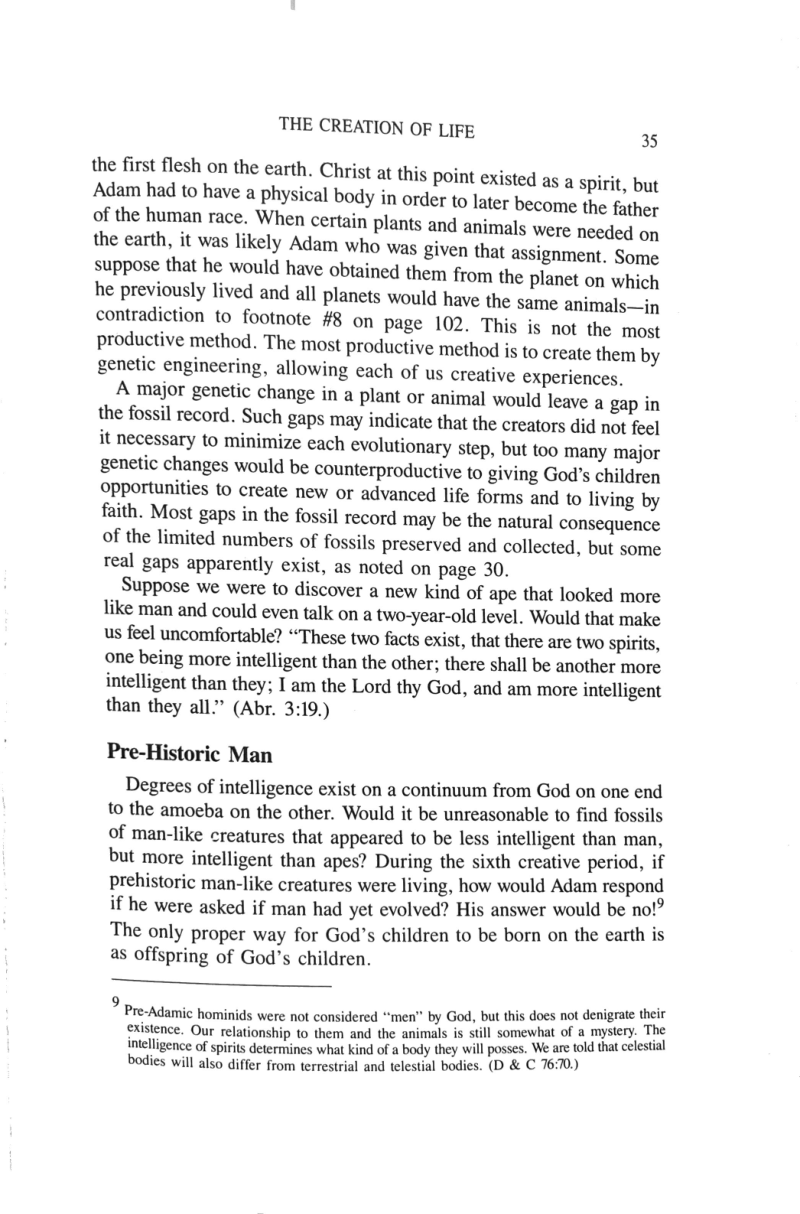William E. Harris discusses Adam's role in the creation.
- Type
- Book
- Source
- William E. Harris LDS
- Hearsay
- Direct
- Reference
William E. Harris, From Man to God: An LDS Scientist Views Creation, Progression, and Exaltation (Bountiful, UT: Horizon Publisher & Distributors, Inc., 1989), 33-35
- Scribe/Publisher
- Horizon Publishers
- People
- William E. Harris
- Audience
- Reading Public
- Transcription
Adam as a Creator
According to LDS doctrine, God instructed Christ and Adam to cause plants and animals to develop on the earth beginning with the simplest types. Evolutionary tendencies were apparently built into the genetic material which allowed sloe evolutionary changes to take place and new species to form to cope with different environments. (This corresponds to Darwin’s survival of the fittest concept.) This is now more correctly described as the survival of the fitter, since living things flourish only if they fit into the environment. If these evolutionary tendencies could add genes and develop chromosomes, why would not God just sit back and let this spontaneous evolution create all the plants and animals of the earth, including man?
The benefit of longevity in the beginning was a definite help as the human race was getting started and learning how to do things. Evolution does not seem to provide for this. Another answer to the question in the above paragraph will be given later, but for now ask yourself, “Hwy does a teacher have lesson plants?” Why not just follow the path where the discussions lead?
God has a specific scope and sequence ordered in the creation. This requires that the evolutionary tendencies built into livings things did not get out of hand. Form time and time, more advanced forms were added by Adam, who was assisted, in an apprentice capacity, by God’s other children. This was done, not because it was impossible to have created them by spontaneous evolution, but to keep pace with the spiritual creation and give God’s children experience in the creation of living things.
At the end of each creative period, God tells us that he “Saw that all things were good.” This is in harmony with the idea that God was observing the creative efforts of others, that some variation was possible, and that it was controlled to meet his specifications. It is possible that some genera and families were created by spontaneous evolution. That would make it unnecessary to genetically engineer or transplant every variety of plant and animal. In either case, it would leave a fossil record that still required faith to believe in God.
Would evolution and creation on other living planets create an identical set of plants and animals? Not as long as artists like to create new and different pictures. Creators like to create, not copy. The primary creation was, however, spiritual. If all things were first created spiritually, how would the physical creation correspond to it if plants and animals were randomly created by chance? What would spirit bears do if evolution on the physical earth did not produce bears? The physical creation had to be controlled to correspond to the preceding spiritual creation.
Many believe that man (Adam) was on earth before the animals and therefore no evolution was possible. In the Pearl of Great Price, we read that man became “the first flesh upon the earth.” If Christ and Adam created the earth under God’s direction, Adam had to be the final flesh on the earth. Christ at this point existed as a spirit, but Adam had to have a physical body in order t o later become the father of the human race. When certain plants and animals were needed on the earth, it was likely Adam who was given that assignment. Some suppose that he would have obtained them from the planet on which he previously lived and all planets would have the same animals—in contradiction to footnote #8 on page 102. This is not the most productive method. The most productive method is to create them y genetic engineering, allowing each of us creative experiences.
A major genetic change in a planet or animal would leave a gap in the fossil record. Such gaps may indicate that the creators did not feel it necessary to minimize each evolutionary step, but too many major genetic changes would be counterproductive to giving God’s children opportunities to create new or advanced life forms and to living by faith. Most gaps in the fossil record may be the natural consequence of the limited number of fossils preserved and collected, but some real gaps apparently exist, as noted on page 30.
Suppose that we were to discover a new kind of ape that looked more like man and could even talk on a two-year-old level. Would that make us feel uncomfortable? “These two facts exist, that there are two spirits, one being more intelligent than the other; there shall be another more intelligent than they; I am the Lord thy God, and am more intelligent than they all.” (Abr. 3:19.)
- Citations in Mormonr Qnas
The B. H. Roberts Foundation is not owned by, operated by, or affiliated with the Church of Jesus Christ of Latter-day Saints.

